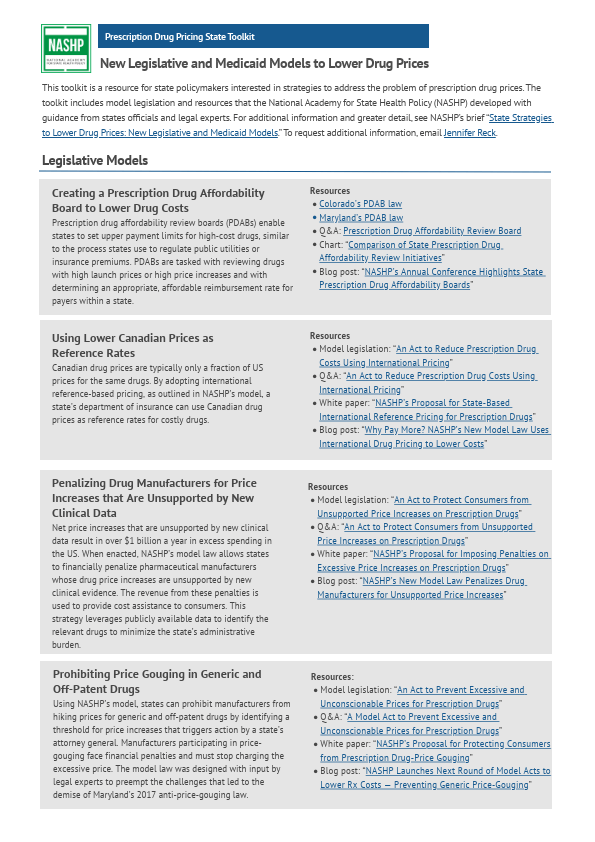This toolkit is a resource for state policymakers interested in strategies to address the problem of prescription drug prices. The toolkit includes model legislation and resources that the National Academy for State Health Policy (NASHP) developed with guidance from states officials and legal experts. For additional information and greater detail, see NASHP’s brief – State Strategies to Lower Drug Prices: New Legislative and Medicaid Models. To request state-only materials and additional information, email Jennifer Reck.
Legislative Models
Prescription drug affordability review boards (PDABs) enable states to set upper payment limits for high-cost drugs, similar to the process states use to regulate public utilities or insurance premiums. PDABs are tasked with reviewing drugs with high launch prices or high price increases and with determining an appropriate, affordable reimbursement rate for payers within a state.
Resources:
- Colorado’s PDAB law
- Maryland’s PDAB law
- Q&A: Prescription Drug Affordability Review Board
- Chart: Comparison of State Prescription Drug Affordability Review Initiatives
- Blog post: NASHP’s Annual Conference Highlights State Prescription Drug Affordability Boards
Canadian drug prices are typically only a fraction of US prices for the same drugs. By adopting international reference-based pricing, as outlined in NASHP’s model, a state’s department of insurance can use Canadian drug prices as reference rates for costly drugs.
Resources:
- Model legislation: An Act to Reduce Prescription Drug Costs Using International Pricing
- Q&A: An Act to Reduce Prescription Drug Costs Using International Pricing
- White paper: NASHP’s Proposal for State-Based International Reference Pricing for Prescription Drugs
- Blog post: Why Pay More? NASHP’s New Model Law Uses International Drug Pricing to Lower Costs
Net price increases that are unsupported by new clinical data result in over $1 billion a year in excess spending in the US. When enacted, NASHP’s model law allows states to financially penalize pharmaceutical manufacturers whose drug price increases are unsupported by new clinical evidence. The revenue from these penalties is used to provide cost assistance to consumers. This strategy leverages publicly available data to identify the relevant drugs to minimize the states administrative burden.
Resources:
- Model legislation: An Act to Protect Consumers from Unsupported Price Increases on Prescription Drugs
- Q&A: An Act to Protect Consumers from Unsupported Price Increases on Prescription Drugs
- White paper: NASHP’s Proposal for Imposing Penalties on Excessive Price Increases on Prescription Drugs
- Blog post: NASHP’s New Model Law Penalizes Drug Manufacturers for Unsupported Price Increases
Using NASHP’s model, states can prohibit manufacturers from hiking prices for generic and off-patent drugs by identifying a threshold for price increases that triggers action by a state’s attorney general. Manufacturers participating in price-gouging face financial penalties and must stop charging the excessive price. The model law was designed with input by legal experts to preempt the challenges that led to the demise of Maryland’s 2017 anti-price-gouging law.
Resources:
- Model legislation: An Act to Prevent Excessive and Unconscionable Prices for Prescription Drugs
- Q&A: A Model Act to Prevent Excessive and Unconscionable Prices for Prescription Drugs
- White paper: NASHP’s Proposal for Protecting Consumers from Prescription Drug-Price Gouging
- Blog post: NASHP Launches Next Round of Model Acts to Lower Rx Costs’ Preventing Generic Price-Gouging
Medicaid Models
The Medicaid programs in Massachusetts and New York have enhanced negotiating authority, which allows Medicaid to negotiate with drug companies for supplemental rebates if drug spending surpasses certain thresholds and to conduct pricing reviews or value assessments when necessary. Enhanced negotiating authority has allowed these states to achieve additional rebates and reduce spending growth without limiting access to high-cost drugs.
Resources:
- Massachusetts authorizing legislation: Section 46 of the Massachusetts FY 2020 Budget
- Massachusetts Health Policy Commission: Final Regulation for Drug Pricing Review
- New York’s authorizing legislation: NY S2007B/Chapter 57
- New York Department of Health: Medicaid Global Spending Cap Implementation homepage
States, as major purchasers of drugs for Medicaid and state employee health plans, can control prescription drug costs by negotiating more favorable contract terms with pharmacy benefit managers (PBMs). Achieving advantageous contract terms with a PBM during the procurement process may supplement or provide an alternative to direct regulation of PBMs for states that do not wish to pursue legislation. These model contract terms enable states to restrict PBM compensation to an administrative-fee-only model, eliminate spread-pricing, require 100 percent pass-through of rebates, and provide robust transparency for greater monitoring and enforcement.
Resources:
- Model contract: Pharmacy Benefit Manager Contract Terms
- Blog post: “Model Pharmacy Benefit Manager Contract Terms Help States Achieve Prescription Drug Savings
Several Medicaid programs are executing outcomes-based contracts with drug manufacturers that require manufacturers to pay rebates if their drug does not meet agreed-upon outcome measures. The Centers for Medicare and Medicaid Services requires state plan amendments (SPAs) to allow states the flexibility to collect supplemental rebates depending on a drug’s performance.
Resources:
- State strategy implementation: Links to approved SPAs and further resources on outcomes-based contracts

The National Academy for State Health Policy’s Center for State Rx Drug Pricing is supported by Arnold Ventures.
